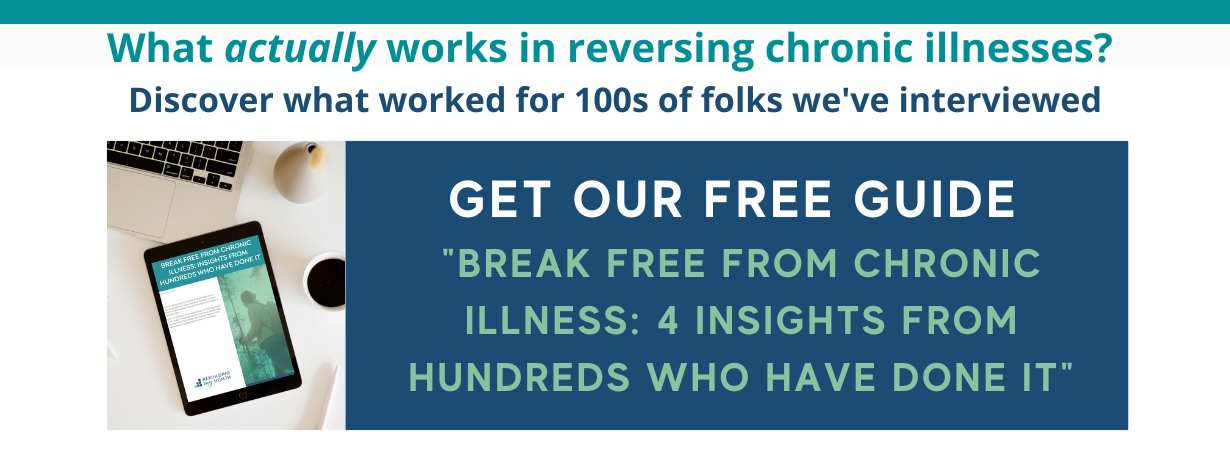Woman Reverses Multiple Sclerosis Symptoms after Swapping Drugs for Diet, Lifestyle
“I stand here, balanced before you, with COMPLETE reversal of my multiple sclerosis symptoms… My recovery on The Wahls Protocol has been extraordinary.”
– Lisa, in a letter written to Dr. Terry Wahls
When faced with a lapse in their health insurance, Lisa Lovely and her family worried about what it would mean for her health.
For years, she had depended on pricey drugs to help control her multiple sclerosis (MS). And the Tysabri infusions she received at the time would cost $5500 every month out of pocket.
With the three-month insurance lapse, she had no choice but to cease taking the monthly disease-modifying infusion drug until new insurance went into effect.
As it turned out, losing insurance was one of the best things that ever happened to her. Otherwise, she may never have gone off the MS infusions.
She never would have discovered the life-altering power of diet and lifestyle changes.
And today, she wouldn’t be able to…
Run, hike or bike…
Think clearly…
Shower or do housework without experiencing severe fatigue and dizziness…
Speak without slurring her words…
Walk up and down stairs without holding onto the rail…
Do active things with her kids…
But instead, she can do all these things, and more.

The First Symptoms of Multiple Sclerosis
In 2011, Lisa diligently trained for the 206-mile Seattle to Portland (STP) bike ride. The married mother of two (ages 4 and 2) was 33 at the time.
But in the months preceding the STP, she gradually lost her 20/20 vision, leading her to visit the eye doctor and get glasses. Then one day, she went blind in her left eye, which lasted for three frustrating months.
Without complete vision and with intense eye pain, sensitivity to light and double vision, she couldn’t see well enough to ride or balance on her bike. She was forced to stop training for the Seattle to Portland bike ride.
But the ride was the least of her worries. The cause of the sudden blindness, extremely poor balance, plus cognitive fog, had her fearing the worst.
After a month of doctor visits, tests finally revealed the cause: optic neuritis, in which inflammation damages the optic nerve. It’s also a possible symptom of multiple sclerosis.
Then brain scans revealed the telltale lesions of the disease – leading doctors to diagnose her with multiple sclerosis (MS).
Up to that point, Lisa had rarely even taken as much as an aspirin. Now she sat in the neurologist’s office with three binders before her, each one with the details and frightening fine print about a different MS drug.
“I was told I needed to pick one drug to fight MS, because it was the only way that MS could be treated,” she says.
She chose Avonex. Administered via weekly injections, Avonex would be least disruptive for her family, she felt.
Lisa began the injections to beat back the disease but suffered with occasional relapses. Usually, that meant her right leg gave out.
All the while, this high-energy “Type A” personality continued with her full life as a special education teacher, fitness instructor and photographer. She wanted to show her kids strength in adversity, so she trained for a half marathon and even completed three Tough Mudders (10+ mile obstacle courses). She kept running – though at times it wasn’t pretty.
“I ran a half marathon during my second relapse,” she says. “At mile nine, my right leg gave out and I dragged it three miles to the finish. I had already missed my Seattle to Portland medal because of optic neuritis, so I wasn’t going to give up mid-race and ask for medical help. I wanted my half marathon medal!”
After that relapse, Lisa’s neurologist presented her with the choice of two new drugs to slow the progression of the disease: Tysabri or Gilenya.
Only those who test negative for the John Cunningham (JCV) virus can take Tysabri because of the significant risks, making Lisa a good candidate for it. So Tysabri, it was.
Finding the Wahls Protocol for MS
As the disease advanced, Lisa reluctantly let go of things she loved as well as things we take for granted every day…
She had to stop running, hiking and biking…
She couldn’t walk more than a half mile…
She couldn’t carry anything without fear of losing her balance and dropping it…
She couldn’t speak without slurring
All the while, Lisa continued searching for alternative MS treatments.
In 2015, she had come across the Wahls Protocol, a diet and lifestyle-centered approach to reducing MS inflammation. Dr. Terry Wahls – who herself has MS – created and applied the diet on herself…and went from wheelchair to walking.
“I watched Dr. Wahls’s Ted Talk and was hooked,” she recalls. “But when I asked my former neurologist about it, the response was ‘Those people don’t last long.’ So, I dropped it. I felt like I needed to stay on the drugs for my family.”
She listened to neurologist, believing doctors knew what was best. But in the fall of 2017, her decline accelerated.
“I was starting to not be able to do little things with my growing kids, like go in a pool (too cold), jump on a trampoline (couldn’t even stand on it), go sledding (too cold), play outside on a summer day (too hot),” she says. “I felt desperate as I got worse and worse.”
She also had to quit her job as a special education teacher. While she continued working as a fitness instructor – with extremely modified movements – and still ran her photography business, doing so grew tougher.
“I tried harder and harder to suppress the havoc that is multiple sclerosis, as it began to rapidly overtake my mind, body, and spirit,” she says. “I have always been the person who is bursting with positivity, determination and independence…but I was becoming a person I didn’t even know.”
Losing Meds…Leads to a Major Decision
When Lisa’s husband changed jobs, and the family faced a three-month lapse in their health insurance, the Tysabri infusions were well beyond their budget.
Despite all of this, Lisa had continued to mull over the Wahls Protocol. Now, without the infusions, it seemed she had nothing to lose in trying it. She re-watched the Ted talk repeatedly and researched the protocol obsessively – and began forming a plan.
“The Wahls Protocol always felt right, despite what my neurologist told me,” she said.
Over dinner with her immediate and extended family, she broached the subject of stopping the infusions. While her family may have thought the decision to be rash and irrational, Lisa had been researching and considering it for several years.
They were scared, she was scared…but she moved ahead anyway. While off the meds, it wouldn’t hurt to try it.
It can be tough enough to cook regular meals when ill. But the Wahls Protocol takes it to another level. Lisa had to really learn how to cook Wahls Protocol meals and dedicate a hefty amount of time to doing so.
The Wahls Protocol calls for eliminating foods such as gluten, grains, dairy, legumes, soy, sugar and eggs. Instead, Lisa had to focus on eating a properly prepared, nutrient-dense diet with well-sourced ingredients to nourish her body.
Lisa began by eliminating gluten and sugar, and immediately noticed decreased fatigue and improved cognition.
“On day two without gluten or sugar, I felt that something was happening,” she recalls. “I felt different, and thought, ‘This is crazy.’”
Through trial and error, she also found specific trigger foods.
“My body couldn’t tolerate eggs,” she says. “I had to change my mind about everything I believed about nutrition.”
Lisa follows the Wahls Protocol 100%, with her body feeling best between levels 2 to 3 of the protocol. Otherwise, with even the smallest exposure to eliminated foods, she risks setting back her immune system. Over time, she didn’t want to cheat anyway as she stopped craving “illegal” foods.
Soon, she noticed her fatigue, dizziness and cognitive fog lessening. She could take a shower and NOT have to rest for 30 minutes afterward.
Then balance and walking started getting easier. Pretty soon, she found she could speak without slurring.
To the Next Level with Lifestyle Changes
Her results multiplied when she combined the diet and lifestyle changes with self-directed therapies:
- Massage therapy – For Lisa, the pain of massage therapy compared only to giving birth as the therapist worked on breaking up the muscle tissue in her hips and legs. During massages, every inch sounded like bubble wrap.
- Physical therapy + Russian E-stim – She strengthened her legs and her “drop foot” on the right leg. E-stim stands for electrical (muscle) stimulation.
- Atlas Orthogonal – She turned to this form of therapy, which uses a percussion wave, a vibration to reposition the atlas vertebra to improve alignment in the body.
- Chiropractic care
- Self-designed workouts
- Daily walks
- Daily stretching (simple yoga stretches that help her with balance)
- Mindfulness
“All these therapies have been instrumental in my recovery,” she says.
Her One-Year Anniversary
Just two months ago, Lisa celebrated one year off Tysabri and on the Wahls Protocol. Gone are the debilitating symptoms she experienced just a year before. She can jog up to two miles, work as a fitness instructor and photographer, and be active with her kids.
She is gradually resuming activities that she loves, including biking, which she began again about two weeks ago – for the first time in 8 years.
Lisa continues to focus on one remaining relic of her MS – drop foot on her right side, which at times fails to cooperate with her wishes. And still, she’s miles from where she was before.
As she shared her story, Lisa bubbled with enthusiasm – and gratitude.
Friends and family had been urging her to write to Dr. Terry Wahls about her experience, and finally she did.
“I stand here, balanced before you, with COMPLETE reversal of my multiple sclerosis symptoms,” she wrote in a letter to Dr. Wahls.
In the letter, posted publicly on her MS Facebook page, she also promised Dr. Wahls that she would pay it forward, and is on track to do so as a full-time Nutritional Therapy Practitioner student, with a graduation date of June 2019.
Her future goals include becoming a Wahls Protocol® Certified Health Professional so she can help support others on the protocol. As a one-income family, she is currently trying to gather the finances via scholarships to get her to Iowa in July 2019, where Dr. Terry Wahls offers an in-person Wahls Protocol® Certified Health Professional certification course.
As she documents her journey on Facebook, Lisa urges those with MS that we must listen to our innate wisdom and that the protocol may work differently for each person. “Give yourself grace,” she advises, regarding following the protocol.
If there’s one thing she’s learned in all this, it’s to trust herself in making healthcare decisions.
“No one is going to fix it for you,” she says. “You have to fix it for yourself.”
If you found this story helpful, you may also like Diet, Exercise Turn Back the Clock on Multiple Sclerosis for Atlanta Man.
The information on this site is for educational and inspirational purposes only and is not intended to replace the advice of qualified professionals. Keep in mind that what works for one person may not work for another. Always consult your healthcare practitioners before beginning new approaches or treatments. Some links on Rebuilding My Health may be affiliate links. This means that we may receive a commission - with no additional cost to you - if you make any purchases using those affiliate links. Rebuilding My Health is a participant in the Amazon Services LLC Associates Program. Learn more.


